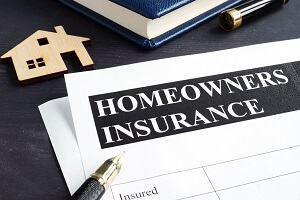 Across the United States, millions of families gather in their homes to celebrate birthdays, anniversaries, holidays, and more. Modern homeowners are given more opportunities than ever to personalize and improve their homes, not only as shelters for their families but as extensions of themselves.
Across the United States, millions of families gather in their homes to celebrate birthdays, anniversaries, holidays, and more. Modern homeowners are given more opportunities than ever to personalize and improve their homes, not only as shelters for their families but as extensions of themselves.
Home security systems have become more advanced, syncing themselves to an owner’s devices, and technology has made household management much more accessible. However, all these trendy and valuable things that families put into their homes are still as vulnerable as ever, as threats from weather, civil unrest, and unexpected disasters can pop up when least expected.
Homeowners must acquire insurance to safeguard themselves and their investments in their homes. Homeowner’s insurance, often called home insurance, provides financial protection from theft and disaster, but the specifics can vary from state to state and policy to policy. Here is what you, as a homeowner, should know about how homeowner’s insurance functions, from its basic structures to the elements that are often excluded.
Homeowner’s Insurance: The Basics
The essential aspects of homeowner’s insurance, no matter where the policy is bought and applied in the United States, are a combination of dwelling coverage and contents coverage, usually with additional general liability coverage.
Dwelling coverage refers to the insured structure itself: the home covered by the insurance plan. If the structure is damaged by several covered possibilities, such as fire, hail, or other disasters, dwelling coverage compensates for repairing or rebuilding the home.
It is important to remember that dwelling coverage does not automatically cover all-natural disasters. Earthquakes, for example, are not covered by standard homeowner’s insurance. The natural wear and tear that can degrade a structure over time is not a substantive reason to qualify for a payout without the presence of other circumstantial damages.
Contents coverage protects the contents of the insured house rather than the house itself. Homeowners can insure their belongings and receive financial compensation if these possessions are stolen or fall victim to an insured disaster.
Although tied to homeowner’s insurance, insured items are protected wherever they are. Because a homeowner’s possessions vary based on hobbies, tastes, and more, pricing on content coverage is complicated and fluctuates for each policy.
Often, companies will only insure the contents of the house up to 50-70 percent of the value of what the physical structure is insured for. A homeowner can insure expensive items like jewelry, collectible items, or silverware, but standard plans will usually not insure them for their total value. The covered disasters are broader than dwelling coverage and typically include fire, theft, vandalism, rioting, lightning, and falling aircraft.
Liability coverage protects the homeowner from lawsuits if another party is injured. Someone gaining large amounts of money by getting hurt at a specific location makes it prudent to protect against the fallout of unexpected injuries.
Within these categories of coverage are other decisions that need to be made by the homeowner, such as how they would like to be compensated for damage to the dwelling. Property can be insured in three ways. With Actual Cash Value coverage, the homeowner will be given money to replace or repair their dwelling.
Still, the compensation will be slightly lower than the property’s initial appraised value to reflect depreciation. Replacement Cost insurance repays the value of the property without factoring in depreciation. However, the last option, Guaranteed/Extended Replacement Cost, offers greater flexibility. Both of the former choices derive the eventual compensation from the appraised cost of replacing the property if they factor in depreciation.
However, they do not account for the fluctuations in construction costs and inflation, so even standard Replacement Cost might not cover everything it implicitly promises. Guaranteed/Extended Replacement Cost covers the actual cost of replacing or repairing the property, even if that cost exceeds the appraisal and policy limit. Guaranteed/Extended Replacement Cost is, therefore, the most expensive of the options, but it offers better protection than the others.
Things That Impact the Cost of Homeowner’s Insurance in Virginia
 While these elements of homeowner’s insurance are mostly standard everywhere in the United States, specific aspects of living in Virginia will impact the exact costs. Home insurance costs in Virginia are relatively low, with homeowners paying average annual insurance premiums of less than $2000, which is approximately 15% lower than the national average.
While these elements of homeowner’s insurance are mostly standard everywhere in the United States, specific aspects of living in Virginia will impact the exact costs. Home insurance costs in Virginia are relatively low, with homeowners paying average annual insurance premiums of less than $2000, which is approximately 15% lower than the national average.
Certain higher-income cities, such as Virginia Beach, Norfolk, or Hampton, will be higher than this average, with annual premiums over $2500, and lower-income cities, such as Arlington or Alexandria, see annual premiums less than $1700 on average.
Other factors besides location influence cost. The square footage of the property, its age, and its condition contribute to higher annual premiums. The potential risk to property and possessions may make insurance providers hesitant to insure items without higher premiums. Standard plans will not cover items of higher value.
Some people try to lower costs and combat the prices of neighborhoods with higher crime rates by minimizing the threat to their property through home security systems. Perhaps the most economical way to reduce the cost of homeowner’s insurance is to pursue all insurance needs through the same provider and bundle them together, getting more coverage for less cost than from individual insurance plans spread across multiple providers.
Do You Need Hurricane and Flood Insurance?
When considering homeowner’s insurance in Virginia, the most important and unique variable will be the weather—specifically hurricanes and flooding. As previously listed, dwelling coverage can be extensive, but almost all standard coverage plans do not include hurricanes and floods in their covered natural disasters.
Most plans include coverage for interior flooding that originates from burst plumbing but not from exterior weather events. This makes sense, as many states and areas nationwide will not have to worry about hurricane damage. Still, for certain coastal states, hurricane damage is a regular threat to families and property.
Homeowners in Virginia should purchase hurricane and flood insurance to add to their existing coverage plans as riders. Despite disparities in hurricane and flood risk among state residents, it is wise to always prepare for the worst.
The best homeowner’s insurance providers in Virginia understand these policies are critical for protecting some of the most valuable assets a person will own in their lifetimes, and they will help customers to secure the flood and hurricane protection they need to enjoy living near the Virginia coastline confidently.
The Coverage That Isn’t Standard
Homeowners’ insurance rarely covers damages beyond hurricane damage unless additional riders or policies are purchased. It might not seem obvious why one disaster is covered, but another is ignored. Which disasters are covered and which are not is a product of calculating risk likelihood and personal liability.
Some significant damage is not covered because it can be reasonably considered natural wear and tear for the property. Damage from invasive creatures like termites who gnaw at the house’s internal structure and from rodents or birds who might weaken its plumbing or wiring is considered expected damage over time. Prolonged smoke damage from neighboring agricultural plants or structural flaws originating from unknown but still present defects in construction will not be covered either.
While some of these circumstances and disasters will not be included in even the most comprehensive homeowner’s insurance policies, more than a few of them are available as additional riders and adjoining coverage plans for those unwilling to shoulder the risk.
 To understand why some occurrences are covered and some aren’t, consider how ensuring possessions becomes a cost calculation. If the contents of the house are so valuable that replacing them would be incredibly expensive for an insurance provider, or if theft is likely enough that the provider might not risk replacing them, no matter their cost, it doesn’t benefit the insurance provider to cover them.
To understand why some occurrences are covered and some aren’t, consider how ensuring possessions becomes a cost calculation. If the contents of the house are so valuable that replacing them would be incredibly expensive for an insurance provider, or if theft is likely enough that the provider might not risk replacing them, no matter their cost, it doesn’t benefit the insurance provider to cover them.
This same base calculation applies to dwelling coverage. If a homeowner is concerned about uncovered disasters or valuable possessions that would not be entirely replaced, they can get extra insurance coverage in addition to the standard coverage. A reputable insurer can help homeowners understand their options about adding more coverage for the risks and possessions of most significant concern.
Get Homeowner’s Insurance Coverage from Industry Experts
Within all the minutiae of homeowner’s insurance, with its varying degrees of coverage, it is a critical product for those who want to protect their home and its contents. It is integral for homeowners to find an insurance provider who understands how to navigate the complexities of the insurance world and their chosen residence and its unique challenges.
The experts at Burton & Company understand how to maximize coverage without adding unnecessary riders. The contents of a dwelling are too often thought of in financial terms rather than the terms of a family who treasures their memories and the safety and security of their residence. Contact us to discuss coverage and determine which policy protections are right for you.

